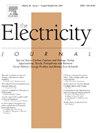Wires and fire: Wildfire investment and network cost differences across California’s power providers
IF 2.2
Q1 Social Sciences
引用次数: 0
Abstract
Electricity affordability is a salient policy concern in California. We compare drivers of increasing utility costs for three types of power providers in California: investor-owned utilities (IOUs), publicly owned utilities (POUs), and community choice aggregators (CCAs). Since 2019, the IOU and CCA residential baseline electricity rates have increased by 44–80 % after accounting for inflation, making them some of the most expensive power providers in the United States. POU prices, however, remained nearly unchanged. We compare long-term trends in capital assets, returns, and operation and maintenance expenses to identify sources of increasing utility costs, one of the factors contributing to rising electricity prices in the state. Across IOUs, generation capital assets have declined. Fuel and power purchase expenses have increased, although these increases remain within their historical ranges. Transmission and distribution (T&D) expenses have increased significantly and are the majority of overall costs. T&D operations and maintenance spiked following major wildfires after years of remaining constant despite an aging and expanding electricity grid. CCAs reach price parity with IOUs due to the high costs of T&D infrastructure and exit fees levied on them. POUs, which service smaller territories with low wildfire risks, also expanded their T&D capital assets, operations, and maintenance expenses, but the increase is modest. We foresee continued price divergence among power providers due to wildfire mitigation costs, which will have important affordability consequences.
电线和火灾:加州电力供应商之间的野火投资和网络成本差异
在加州,电力的可负担性是一个突出的政策问题。我们比较了加州三种类型的电力供应商的公用事业成本增加的驱动因素:投资者拥有的公用事业(iou)、公共拥有的公用事业(pou)和社区选择的聚合商(cca)。自2019年以来,考虑到通货膨胀因素,IOU和CCA住宅基准电价上涨了44 - 80% %,使它们成为美国最昂贵的电力供应商之一。然而,POU价格几乎保持不变。我们比较了资本资产、回报、运营和维护费用的长期趋势,以确定公用事业成本增加的来源,这是导致该州电价上涨的因素之一。在所有借据中,发电资本资产都有所下降。燃料和电力购买费用有所增加,但增幅仍在历史范围内。输电和配电(T&;D)费用大幅增加,占总成本的大部分。尽管电网不断老化和扩大,输配电运营和维护费用多年来一直保持不变,但在发生重大火灾后,输配电运营和维护费用飙升。由于输配电基础设施的高成本和对其征收的退出费,cca达到了与借据的价格平价。服务于野火风险较低的较小地区的ppo也增加了他们的研发资本资产、运营和维护费用,但增长幅度不大。我们预计,由于缓解野火的成本,电力供应商之间的价格将继续出现分歧,这将产生重要的负担能力后果。
本文章由计算机程序翻译,如有差异,请以英文原文为准。
求助全文
约1分钟内获得全文
求助全文
来源期刊

Electricity Journal
Business, Management and Accounting-Business and International Management
CiteScore
5.80
自引率
0.00%
发文量
95
审稿时长
31 days
期刊介绍:
The Electricity Journal is the leading journal in electric power policy. The journal deals primarily with fuel diversity and the energy mix needed for optimal energy market performance, and therefore covers the full spectrum of energy, from coal, nuclear, natural gas and oil, to renewable energy sources including hydro, solar, geothermal and wind power. Recently, the journal has been publishing in emerging areas including energy storage, microgrid strategies, dynamic pricing, cyber security, climate change, cap and trade, distributed generation, net metering, transmission and generation market dynamics. The Electricity Journal aims to bring together the most thoughtful and influential thinkers globally from across industry, practitioners, government, policymakers and academia. The Editorial Advisory Board is comprised of electric industry thought leaders who have served as regulators, consultants, litigators, and market advocates. Their collective experience helps ensure that the most relevant and thought-provoking issues are presented to our readers, and helps navigate the emerging shape and design of the electricity/energy industry.
 求助内容:
求助内容: 应助结果提醒方式:
应助结果提醒方式:


